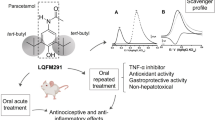The aim of this work was to study the systemic antinociceptive and anti-inflammatory effects and to evaluate the gastropathic effects of L-proline and L-tryptophan sulfamide derivatives on experimental models in rodents as compared to diclofenac. The target compounds were synthesized by the reaction of 4-(tert-butyl)-benzenesulfonyl chloride, which was previously obtained from tert-butylbenzene and chlorosulfonic acid, with the amino acids L-tryptophan and L-proline in aqueous NaOH solution. The target sulfamic acids were obtained in high yields and did not require further purification. The acids were converted to water-soluble sodium salts for subsequent pharmacological tests. The investigational compounds and diclofenac were administered intragastrically in doses of 10 mg/kg of body weight. The L-tryptophan sulfamide derivative demonstrated an antinociceptive effect close to that of diclofenac in the acetic acid-induced writhing test in mice. The number of writhings in each group decreased by 97% as compared with the control (p = 0.03 for diclofenac; p > 0.05 for the tryptophan derivative). The anti-inflammatory activity of the L-tryptophan sulfamide derivative on a formalin-induced paw edema model in rats exceeded that of diclofenac by 78% (p = 0.02). The L-proline sulfamide derivative did not exhibit antinociceptive and anti-inflammatory activity in the studied dose. In addition, L-proline and especially L-tryptophan sulfamide derivatives administered for 14 d had significantly lower ulcerogenic effects in rats as compared to diclofenac when assessing the degree of gastric ulceration and the percentage of rats that developed gastric ulcers. The L-tryptophan sulfamide derivative appears to be a promising compound from the viewpoint of balancing the analgesic and anti-inflammatory activities and gastrointestinal safety.


Similar content being viewed by others
References
N. A. Shostak, N. G. Pravdyuk, V. T. Timofeev, et al., Ross. Med. Zh., 9, 648 – 652 (2017).
S. P. Cohen, L. Vase, and W. M. Hooten, Lancet, 397, 2082 – 2097 (2021).
A. E. Karateev, E. L. Nasonov, V. T. Ivashkin, et al., Nauchno-Prakt. Revmatol., 56(1),1– 29 (2018).
V. S. Kosorukov, G. R. Abuzarova, E. R. Zakharochkina, et al., Opukholi Golovy Shei, 12(2), 89 – 107 (2022).
H. Azevedo-Barbosa, D. F. Dias, L. L. Franco, et al., Mini-Rev. Med. Chem., 20(19), 2052 – 2066 (2020).
C. T. Supuran, Molecules, 22(10), 1642 (2017).
J. Y. Winum, A. Scozzafava, J. L. Montero, et al., Med. Res. Rev., 26(6), 767 – 792 (2006).
Interstate Standard GOST 33044-2014 “Good laboratory practice rules” [in Russian].
Russian Federation National Standard GOST 33216-2014 “Guidelines for accommodation and care of animals. Species-specific provisions for laboratory rodents and rabbits” [in Russian].
Russian Federation National Standard GOST 33215-2014 “Guidelines for accommodation and care of animals. Environment, housing and management” [in Russian].
Federal Law No. 61-FZ of Apr. 12, 2010 “On drug circulation” [in Russian].
Directive 2010 / 63 / Eu of the European Parliament and European Union Council of Sept. 22, 2010 “Protection of animals used for scientific purposes.”
Guide for the Care and Use of Laboratory Animals, 8th Ed., The National Academies Press, Washington, D. C. (2011).
F. M. Steckling, F. D. Lima, and J. B. Farinha, Scand. J. Med. Sci. Sports, 30(2), 264 – 271 (2020).
I. Naz, M. S. Masoud, Z. Chauhdary, et al., J. Food Biochem., 46(12), 143 – 189 (2022).
L. H. Santos, C. A. Feres, F. H. Melo, et al., Braz. J. Med. Biol. Res., 37(8), 1205 – 1213 (2004).
A. Dogra, A. Gour, S. Bhatt, et al., Xenobiotica, 50(11), 133 – 240 (2020).
A. N. Mironov (ed.), Handbook for Preclinical Drug Studies, Grif i K, Moscow (2012).
G. Cantarella, G. Martinez, V. M. Cutuli, et al., Eur. J. Pharmacol., 518(2), 221 – 226 (2005).
D. A. Bondarenko, I. A. D’yachenko, D. I. Skobtsov, et al., Biomeditsina, 2, 84 – 94 (2011).
M. I. Ortiz, Pharmacol. Biochem. Behav., 99,1–6 (2011).
M. I. Ortiz and G. Castaneda-Hernandez, Pharmacol. Biochem. Behav., 102, 163 – 169 (2012).
M. I. Ortiz, Can. J. Physiol. Pharmacol., 95(1), 51 – 58 (2017).
F. M. Steckling, F. D. Lima, J. B. Farinha, et al., Scand. J. Med. Sci. Sports, 30(2), 264 – 271 (2020).
A. G. Vasil’chuk, E. A. Ivanova, A. I. Matyushkin, et al., Biologiya, 77(1), 22 – 28 (2022).
J. L. Wallace, S. Syer, E. Denou, et al., Gastroenterology, 141(4), 1314 – 1322 (2011).
K. Celinski, S. J. Konturek, P. C. Konturek, et al., J. Pineal Res., 50(4), 389 – 394 (2011).
Acknowledgments
The studies were financed by Yaroslavl State Medical University, Ministry of Health of Russia, and Yaroslavl State Technical University.
Author information
Authors and Affiliations
Corresponding author
Additional information
Translated from Khimiko-Farmatsevticheskii Zhurnal, Vol. 57, No. 6, pp. 30 – 36, June, 2023.
Rights and permissions
Springer Nature or its licensor (e.g. a society or other partner) holds exclusive rights to this article under a publishing agreement with the author(s) or other rightsholder(s); author self-archiving of the accepted manuscript version of this article is solely governed by the terms of such publishing agreement and applicable law.
About this article
Cite this article
Sidorov, A.V., Gerasimova, N.P., Askirko, N.V. et al. Synthesis and Investigation of Antinociceptive, Anti-Inflammatory, and Ulcerogenic Potential of L-Tryptophan and L-Proline Sulfamide Derivatives. Pharm Chem J 57, 828–833 (2023). https://doi.org/10.1007/s11094-023-02956-4
Received:
Published:
Issue Date:
DOI: https://doi.org/10.1007/s11094-023-02956-4




